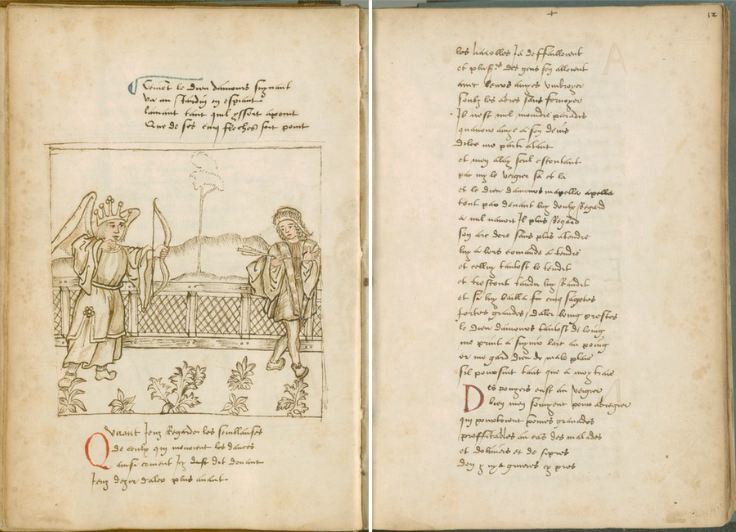Welcome to WordPress. This is your first post. Edit or delete it, then start writing!
Roman de la Rose Digital Library at Kalamazoo IMC 2018
Website Launch: The Archaeology of Reading in Early Modern Europe
Images unavailable temporarily
We apologize, but due to some technical issues, manuscript images are temporarily unavailable. The website works, but you will be unable to see manuscript images in the various viewers. Images will gradually come back online over the course of a few weeks. We will update this post with more information as it becomes available.
Thank you for your patience.
Update on 11/6: About 60% of the images are available now. We expect all the images to be available by 11/18.
Update on 11/14: All of the images are available.
September 2014 Updates
Funding for ‘Archaeology of Reading’
The Sheridan Libraries of Johns Hopkins University are delighted to announce an award of $488,000 from the Andrew W. Mellon Foundation for the new digital humanities research initiative “The Archaeology of Reading in Early Modern Europe.” In conjunction with University College London’s Centre for Editing Lives and Letters (CELL), and the Princeton University Library, the project will explore historical reading practices through the lens of manuscript annotations preserved in early printed books.
The initiative is under the leadership of Hopkins’ Earle Havens, the William Kurrelmeyer Curator of Rare Books and Manuscripts at the Sheridan Libraries, who will be working with co-Principal Investigators Professor Lisa Jardine, Director of CELL at University College London; and Professor Anthony Grafton of the Department of History at Princeton.
Over the past decades there has been a great deal of humanistic research focused upon the Printing Revolution of the sixteenth century and the reading habits of early modern book owners who filled their tomes with interpretative handwritten marginalia. These annotations still offer a wealth of untapped research materials, which demonstrate how readers adapted to the new print medium.
The initial phase of activity of the project will focus around the transcription and translation of a select number of heavily annotated books, and the allied adaptation of the open-access SharedCanvas viewer to maximize user interaction with these complex, composite early modern texts through a publicly available website. The development of the SharedCanvas viewer will also benefit the Roman de la Rose Digital Library, which will be using this technology in the future to display and digitally annotate Rose manuscripts.
For further information view the Hopkins press release or contact Brian Shields. Tel: 410-516-8337/443-631-2890; email: bshields@jhu.edu.
Rose on Twitter
For those of you who are regular visitors to the Roman de la Rose Digital Library blog, you will probably be noticing some changes. In addition to a slight makeover of our blog style, the most obvious new feature is our fabulous Twitter feed in the right hand column.
Since the beginning of May our Twitter handle, @RoseDigLib, has been hosting some experiments with medieval ‘twitterature’. The project was conceived by Tamsyn Rose-Steel (@TamsynMedieval), CLIR/Mellon postdoctoral fellow at Johns Hopkins University, and utilizes the talents of poet Mike Rose-Steel (@MikeRStyping), who is a PhD candidate at Exeter University and is funded by Exeter’s ‘Bridging the Gaps’ Wiring Wittgenstein project. Guillaume de Lorris’s original poem of around 4,000 lines has been rendered into approximately 200 tweets in modern English rhyming couplets and quatrains, often accompanied by some of the stunning manuscript images that we host here on the Rose Digital Library. Follow us to enjoy this new rendering of the Rose.
To explain the philosophy behind the endeavor and how we handled the constraints on the Twitter medium, some pages will be added to this blog exploring our ideas in greater depth. The first mini-essay ‘Medieval Twitterature’ has already been posted – click on the tab under the header to start reading. We hope you enjoy experiencing this most seminal of medieval French works in a new way.
Images temporarily unavailable
Due to an issue with our image serving software, some manuscript images are temporarily unavailable. If an image is unavailable, you will see a “gear” icon for it. Images are coming back online gradually in a process that will take about two days.
Thank you for your patience.
Update on 4/24
Images are coming back online steadily, but slower than we hoped.
All images should be available by 4/28.
Update on 4/28
80% of the images are available. The rest should be online by 4/30.
Update on 5/1
All of the images are available.
2013 Usage Statistics
After another long delay, we promise to get back on track with posting these statistics. Please comment if you find these interesting, and if so, how often you would like to see them. For a start, here is 2013.
24,476 visits from 136 countries or territories
The top five countries represented (in order): United States, France, United Kingdom, Canada, Italy
14,579 absolute unique visitors
42% of these visitors have returned to the site
804 of these visitors have used the site 9-14 times
693 of these visitors have used the site 15-25 times
737 of these visitors have used the site 26-50 times
517 of these visitors have used the site 51-100 times
598 of these visitors have used the site 101-200 times
1,968 of these visitors have used the site more than 200 times
1,634 of these visits lasted between 10 and 30 minutes
1,363 of these visits lasted longer than 30 minutes
Since the launch of the site in September 2008 through December 31, 2012, the Rose team has noted the following usage statistics:
111,968 visits from 170 countries or territories
The top five countries represented (in order): United States, France, United Kingdom, Italy, Canada
71,456 absolute unique visitors
36% of these visitors have returned to the site
3,533 of these visitors have used the site 9-14 times
3,157 of these visitors have used the site 15-25 times
3,065 of these visitors have used the site 26-50 times
2,665 of these visitors have used the site 51-100 times
2,479 of these visitors have used the site 101-200 times
4,334 of these visitors have used the site more than 200 times
8,127 of these visits lasted between 10 and 30 minutes
6,125 of these visits lasted longer than 30 minutes
2012 Usage Statistics
We have not shared our usage statistics in quite some time, so here is some information about use of the Roman de la Rose Digital Library for the period January 1, 2012-December 31, 2012:
23,478 visits from 126 countries or territories
The top five countries represented (in order): United States, France, Italy, United Kingdom, Germany
14,707 absolute unique visitors
39% of these visitors have returned to the site
769 of these visitors have used the site 9-14 times
728 of these visitors have used the site 15-25 times
688 of these visitors have used the site 26-50 times
771 of these visitors have used the site 51-100 times
684 of these visitors have used the site 101-200 times
629 of these visitors have used the site more than 200 times
1,777 of these visits lasted between 10 and 30 minutes
1,298 of these visits lasted longer than 30 minutes
Since the launch of the site in September 2008 through December 31, 2012, the Rose team has noted the following usage statistics:
87,522 visits from 161 countries or territories
The top five countries represented (in order): United States, United Kingdom, France, Italy, Spain
57,202 absolute unique visitors
35% of these visitors have returned to the site
2,729 of these visitors have used the site 9-14 times
2,464 of these visitors have used the site 15-25 times
2,328 of these visitors have used the site 26-50 times
2,148 of these visitors have used the site 51-100 times
1,881 of these visitors have used the site 101-200 times
2,366 of these visitors have used the site more than 200 times
6,493 of these visits lasted between 10 and 30 minutes
4,762of these visits lasted longer than 30 minutes




